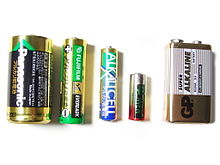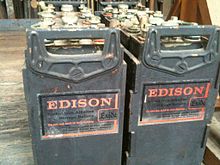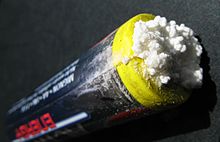Alkaline battery
 From left to right: C, AA, AAA, N, and 9V alkaline batteries | |
| Self-discharge rate | <0.3%/month |
|---|---|
| Time durability | 5–10 years |
| Nominal cell voltage | 1.5 V |
Alkaline batteries (IEC code: L) are a type of primary battery dependent upon the reaction between zinc and manganese(IV) oxide (Zn/MnO2). A rechargeable alkaline battery allows reuse of specially designed cells.
Compared with zinc-carbon batteries of the Leclanché or zinc chloride types, alkaline batteries have a higher energy density and longer shelf-life, with the same voltage. Button cell silver-oxide batteries have higher energy density and capacity but also have a higher cost than similar-size alkaline cells.
The alkaline battery gets its name because it has an alkaline electrolyte of potassium hydroxide, instead of the acidic ammonium chloride or zinc chloride electrolyte of the zinc-carbon batteries. Other battery systems also use alkaline electrolytes, but they use different active materials for the electrodes.
Alkaline batteries account for 80% of manufactured batteries in the US and over 10 billion individual units produced worldwide. In Japan alkaline batteries account for 46% of all primary battery sales. In Switzerland alkaline batteries account for 68%, in the UK 60% and in the EU 47% of all battery sales including secondary types.[1][2][3][4][5]
Alkaline batteries are used in many household items such as MP3 players, CD players, digital cameras, pagers, toys, lights, and radios, to name a few.
History

Batteries with alkaline (rather than acid) electrolyte were first developed by Waldemar Jungner in 1899, and, working independently, Thomas Edison in 1901. The modern alkaline dry battery using the zinc/manganese (IV) oxide chemistry was invented by Canadian engineer Lewis Urry in the 1950s while working for Union Carbide's Eveready Battery division in Cleveland, OH, building on earlier work by Edison.[6] On October 9, 1957, Urry, Karl Kordesch, and P.A. Marsal filed US patent (2,960,558) for the alkaline battery. It was granted in 1960 and was assigned to the Union Carbide Corporation.[7]
When introduced in the late 1960s, alkaline batteries contained a small amount of toxic mercury amalgam to control side reactions at the zinc cathode. With mercury content reduced by law and improvements in the purity and consistency of materials, manufacturers have reduced the mercury content in modern cells.[8]
Chemistry
In an alkaline battery, the negative electrode is zinc and the positive electrode manganese (IV) oxide. The alkaline electrolyte of potassium hydroxide is not part of the reaction, only the zinc and manganese (IV) oxide are consumed during discharge. The alkaline electrolyte of potassium hydroxide remains, as there are equal amounts of OH− consumed and produced.

The half-reactions are:
- Zn(s) + 2OH−(aq) → ZnO(s) + H2O(l) + 2e− [e° = -1.28 V]
- 2MnO2(s) + H2O(l) + 2e− → Mn2O3(s) + 2OH−(aq) [e° = +0.15 V]
Overall reaction:
- Zn(s) + 2MnO2(s) ⇌ ZnO(s) + Mn2O3(s) [e° = +1.43 V]
Capacity

Capacity of an alkaline battery is greater than an equal size Leclanché cell or zinc-chloride cell because the manganese (IV) oxide is purer and denser, and space taken up by internal components such as electrodes is less. An alkaline cell can provide between three and five times capacity.
The capacity of an alkaline battery is strongly dependent on the load. An AA-sized alkaline battery might have an effective capacity of 3000 mAh at low drain, but at a load of 1 ampere, which is common for digital cameras, the capacity could be as little as 700 mAh. The voltage of the battery declines steadily during use, so the total usable capacity depends on the cut-off voltage of the application. Unlike Leclanche cells, the alkaline cell delivers about as much capacity on intermittent or continuous light loads. On a heavy load, capacity is reduced on continuous discharge compared with intermittent discharge, but the reduction is less than for Leclanche cells.
Voltage
The nominal voltage of a fresh alkaline cell is 1.5 V. Multiple voltages may be achieved with series of cells. The effective zero-load voltage of a non discharged alkaline battery varies from 1.50 to 1.65 V, depending on the purity of the manganese (IV) oxide used and the contents of zinc oxide in the electrolyte. The average voltage under load depends on level of discharge and the amount of current being drawn, varying from 1.1 to 1.3 V. The fully discharged cell has a remaining voltage in the range of 0.8 to 1.0 V.[8]
Current
The amount of current an alkaline battery can deliver is roughly proportional to its physical size. This is a result of decreasing internal resistance as the internal surface area of the cell increases. A general rule of thumb is that an AA alkaline battery can deliver 700 mA without any significant heating. Larger cells, such as C and D cells, can deliver more current. Applications requiring currents of several amperes, such as powerful flashlights and portable stereos, will require D-sized cells to handle the increased load.
Construction
Alkaline batteries are manufactured in standardized cylindrical forms interchangeable with zinc-carbon batteries, and in button forms. Several individual cells may be interconnected to form a true "battery", such as those sold for use with flashlights and the 9 volt transistor-radio battery.
A cylindrical cell is contained in a drawn steel can, which is the cathode connection. The positive electrode mixture is a compressed paste of manganese (IV) oxide with carbon powder added for increased conductivity. The paste may be pressed into the can or deposited as pre-molded rings. The hollow center of the cathode is lined with a separator, which prevents contact of the electrode materials and short-circuiting of the cell. The separator is made of a non-woven layer of cellulose or a synthetic polymer. The separator must conduct ions and remain stable in the highly alkaline electrolyte solution.
The negative electrode is composed of a dispersion of zinc powder in a gel containing the potassium hydroxide electrolyte. The zinc powder provides more surface area for chemical reactions to take place, compared to a metal can. This lowers the internal resistance of the cell. To prevent gassing of the cell at the end of its life, more manganese dioxide is used than required to react with all the zinc.
When describing AAA, AA, C, sub-C and D size cells, the negative electrode is connected to the flat end, and the positive terminal is the end with the raised button. This is usually reversed in button cells, with the flat ended cylindrical can being the positive terminal.
Recharging of alkaline batteries
Some alkaline batteries are designed to be recharged (see rechargeable alkaline battery), but most are not. Attempts to recharge may cause rupture, or the leaking of hazardous liquids which will corrode the equipment.
Leaks

Alkaline batteries are prone to leaking potassium hydroxide, a caustic agent that can cause respiratory, eye and skin irritation.[note 1] This can be reduced by not attempting to recharge disposable alkaline cells, not mixing different battery types in the same device, replacing all of the batteries at the same time, storing in a dry place, and removing batteries for storage of devices.
All batteries gradually self-discharge (whether installed in a device or not) and dead batteries will eventually leak. Extremely high temperatures can also cause batteries to rupture and leak (such as in a car during summer).
The reason for leaks is that as batteries discharge — either through usage or gradual self-discharge — the chemistry of the cells changes and some hydrogen gas is generated. This out-gassing increases pressure in the battery. Eventually, the excess pressure either ruptures the insulating seals at the end of the battery, or the outer metal canister, or both. In addition, as the battery ages, its steel outer canister may gradually corrode or rust, which can further contribute to containment failure.
Once a leak has formed due to corrosion of the outer steel shell, potassium hydroxide absorbs carbon dioxide from the air to form a feathery crystalline structure of potassium carbonate that grows and spreads out from the battery over time, following along metal electrodes to circuit boards where it commences oxidation of copper tracks and other components, leading to permanent circuitry damage.
The leaking crystalline growths can also emerge from seams around battery covers to form a furry coating outside the device, that corrodes any objects in contact with the leaking device.
Disposal
With the reduction in mercury in 1996, alkaline batteries are allowed to be disposed of as regular domestic waste in some locations. However, older alkaline batteries with mercury, and the remaining other heavy metals and corrosive chemicals in all batteries (new and old), still present problems for disposal--especially in landfills.[9][10] There is also the issue of simplifying the disposal of batteries to exclude them all so that the most toxic will be diverted from general waste streams.
Disposal varies by jurisdiction. For example the state of California considers all batteries as hazardous waste when discarded, and has banned the disposal of batteries with other domestic waste.[11] In Europe, battery disposal is controlled by the WEEE Directive and Battery Directive regulations, and as such alkaline batteries must not be thrown in with domestic waste. In the EU, most stores that sell batteries are required by law to accept old batteries for recycling.
Recycling
Alkaline batteries do not contain valuable materials, so disposal has a net cost to the party disposing of the material.
In the US, one company shreds and separates the battery case metals, manganese and zinc.[12] Another company mixes batteries in as a feedstock in steel making furnaces, to make low-grade steel such as rebar; the zinc fumes are recovered separately.[13]
See also
- History of the battery
- Battery nomenclature
- Lewis Urry
- Oxyride battery
- Rechargeable battery
- Rechargeable alkaline battery
- Recharging alkaline batteries
- List of battery sizes
- Battery recycling
- Battery holder
- Battery types
- Edison-Lalande cell (an early alkaline primary battery)
- Comparison of battery types
Notes
- ^ This alkali particularly attacks aluminium, a common material for flashlights, which can be damaged by leaking alkaline batteries.
References
- ^ Olivetti, Elsa; Jeremy Gregory; Randolph Kirchain (February 2011). "Life Cycle Impacts of Alkaline Batteries with a Focus on End-of-Life - EBPA-EU" (PDF). Massachusetts Institute of Technology, Materials Systems Lab. p. 110. Retrieved 29 July 2014.
{{cite web}}:|archive-url=is malformed: timestamp (help)[dead link] - ^ "BAJ Website - Monthly battery sales statistics". Battery Association of Japan. Mar 2011. Retrieved 29 July 2014.
{{cite web}}:|archive-url=is malformed: timestamp (help)[dead link] - ^ "Absatzzahlen 2008" (PDF) (in German). Interessenorganisation Batterieentsorgung. Archived from the original (PDF) on March 25, 2012. Retrieved 29 July 2014.
{{cite web}}: Unknown parameter|deadurl=ignored (|url-status=suggested) (help) - ^ Fisher, Karen; Wallén, Erika; Laenen, Pieter Paul; Collins, Michael (18 October 2006). "Battery Waste Management Life Cycle Assessment Final Report for Publication" (PDF). Environmental Resources Management, DEFRA. p. 230. Retrieved 29 July 2014.
- ^ "EPBA Battery Statistics - 2000". European Portable Battery Association. 2000. Archived from the original on March 21, 2012. Retrieved 29 July 2014.
{{cite web}}: Unknown parameter|deadurl=ignored (|url-status=suggested) (help) - ^ Baird, Gabriel. "Thomas Edison provided Lew Urry spark of idea for better alkaline battery: Greater Cleveland Innovations". cleveland.com. Retrieved 17 November 2014.
- ^ US Patent 2960558 Template:En icon
- ^ a b Reddy, David Linden, Thomas B. (2001). Linden's handbook of batteries (3 ed.). New York: McGraw-Hill. pp. 10–12. ISBN 0-07-135978-8.
{{cite book}}: CS1 maint: multiple names: authors list (link) - ^ Environmental Services Department. "Battery Recycling". City of San Diego. Retrieved 5 September 2012.
- ^ Raw Materials Company. "Frequently Asked Questions". Retrieved 5 September 2012.
- ^ "Batteries". Waste Prevention Information Exchange. California Department of Resources Recycling and Recovery (CalRecycle). Retrieved 5 September 2012.
- ^ Toxco, Inc. "About Battery Recycling". Retrieved 5 September 2012.
- ^ "How Battery Recycling Works". Batteryrecycling.com. Retrieved 2013-06-08.

